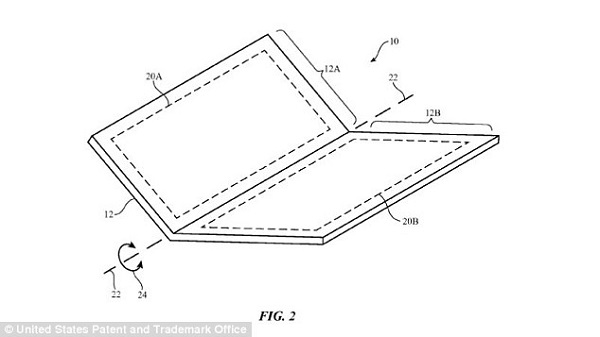Last month, it was reported that Apple and LG Display are partnering to develop a foldable iPhone. LG Display recently created a task force to develop a bendable OLED screen for the foldable phone model. Its sister company LG Innotek also formed a team devoted to the development of the rigid flexible PCB, or RFPCB, according to a news article from the Investors.
 |
|
(Image: the United States Patent and Trademark Office) |
The US Patent & Trademark Office this month published a patent application related to the foldable iPhone from Apple. In this patent, the iPhone maker includes Micro LED as one of the display materials for the model and liquid metal as the bendable part of the phone structure, Patently Apple shared.
The patent illustrates a device that has a flexible part which allows it to be folded and a flexible display that bends along.
The flexible display consists of several layers, including a flexible display layer, a cover layer, a support layer, and a polarizer layer. A touch sensor will be insinuated between the flexible display and the cover layer, and the polarizer layer will be placed either on or under the touch sensor.
The touch sensor also includes layers of adhesive facilitating bending of the display. Additives in the adhesive should be able to reduce water vapor penetration, avoid corrosion, block ultraviolet light, and adjust index of refraction.
The support layer may be made with shape memory alloy (SMA) or amorphous metal and have openings allowing the display to bend along the bend axis.
Another Apple patent titled “Electronic Devices with Displays” also covers designs of a folding device. The patent shows the device may have a flexible display and a housing. Their edge portions are joined along a flexible middle portion that may overlap a bend axis. It also mentions the display layer could be a OLED or Micro LED layer.
The invention can be applied to devices such as iPhone, iPad, and MacBook and to display materials including LCD, OLED, and Micro LED.
Apple has reportedly started collaboration with TSMC to develop silicon-based Micro LED displays to dodge some mass transfer challenges. The act to downsize the team in Taiwan may reflect the firm completes the research and is ready to move to the next stage which is expected to be carried out in the US.












